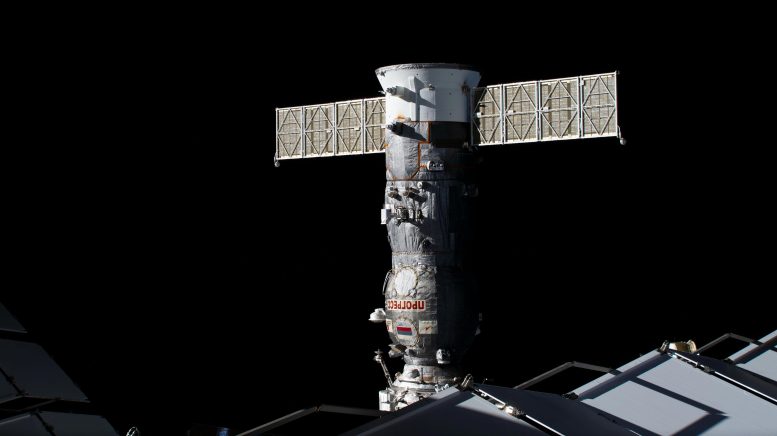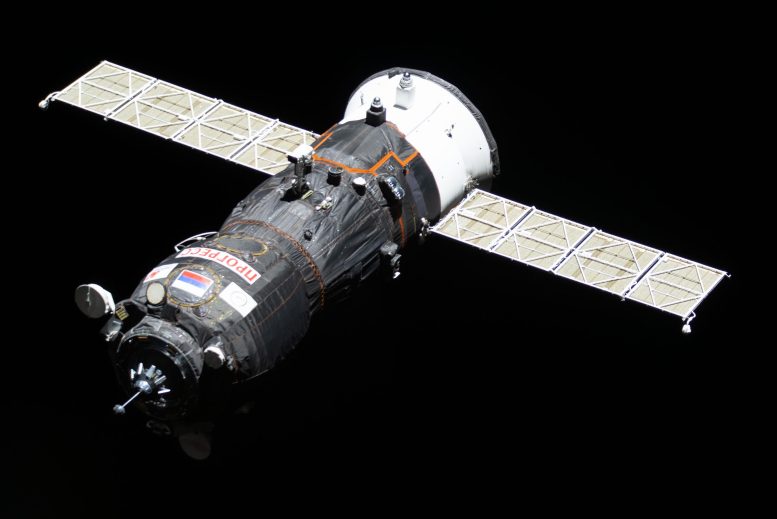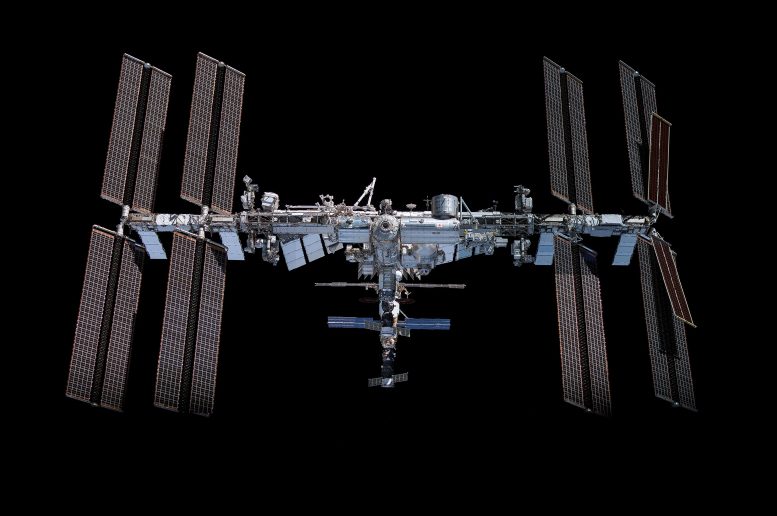
The Roscosmos Progress 84 cargo craft is pictured docked to the International Space Station’s Poisk module. Credit: NASA
NASA will provide live launch and docking coverage of the Roscosmos Progress 86 cargo spacecraft carrying about three tons of food, fuel, and supplies for the Expedition 70 crew aboard the International Space Station (ISS).
The unpiloted spacecraft is scheduled to launch at 4:25 a.m. EST on Friday, December 1 (2:25 p.m. Baikonur time), on a Soyuz rocket from the Baikonur Cosmodrome in Kazakhstan.
NASA coverage will begin at 4 a.m. on the NASA+ streaming service via the web or the NASA app. Coverage also will air live on NASA Television, YouTube, and on the agency’s website. Learn how to stream NASA TV through a variety of platforms including social media.
The Progress spacecraft will be placed into a two-day, 34-orbit journey to the station, leading to an automatic docking to the Poisk module at 6:14 a.m. Sunday, Dec. 3. Coverage of rendezvous and docking will begin at 5:30 a.m. on NASA Television and the agency’s website.
The spacecraft will remain at the orbiting laboratory for approximately six months, then undock for a destructive but safe re-entry into Earth’s atmosphere to dispose of trash loaded by the crew.

Russia’s Progress 72 resupply ship is pictured approaching the International Space Station’s Pirs docking compartment carrying 3.7 tons of food, fuel, and supplies for the Expedition 59 crew. Credit: NASA
Progress Cargo Spacecraft
The Progress cargo spacecraft, developed by the Soviet Union and now operated by Roscosmos, Russia’s space agency, is a key component in ongoing space exploration and support. Designed primarily for resupply missions, it is an automated, unpiloted spacecraft that delivers essential supplies to space stations. This includes food, fuel, equipment, and other materials necessary for the crew aboard the International Space Station (ISS).
Progress spacecraft are launched atop Soyuz rockets from sites such as the Baikonur Cosmodrome in Kazakhstan. They are capable of automatically docking with the ISS, a process overseen by ground control and, if necessary, the ISS crew. Each spacecraft’s cargo capacity allows it to transport several tons of supplies.
After the cargo is unloaded and the spacecraft is refilled with waste material from the ISS, it undocks and eventually re-enters the Earth’s atmosphere. The re-entry is typically a controlled, destructive process, where the spacecraft burns up, safely disposing of the onboard waste.
Over the years, Progress spacecraft have been critical in maintaining the operation and habitation of space stations, providing regular and reliable support for various missions, and ensuring the well-being and productivity of space crews.

This mosaic depicts the International Space Station pictured from the SpaceX Crew Dragon Endeavour during a fly around of the orbiting lab that took place following its undocking from the Harmony module’s space-facing port on November 8, 2021. Credit: NASA
International Space Station
The International Space Station (ISS) is a marvel of modern space exploration and international cooperation. Orbiting Earth since 1998, it serves as a microgravity and space environment research laboratory where scientific research is conducted in astrobiology, astronomy, meteorology, physics, and other fields. The ISS is a joint project involving space agencies from the United States (NASA), Russia (Roscosmos), Europe (ESA), Japan (JAXA), and Canada (CSA).
Spanning the size of a football field, the ISS includes living quarters, laboratories, and solar panels to provide power. It travels at an average altitude of approximately 420 kilometers (260 miles) above Earth, circling the planet every 90 minutes at a speed of about 28,000 kilometers per hour (17,500 mph). This unique vantage point not only allows for advanced scientific research but also provides breathtaking views of the Earth.
Astronauts and cosmonauts from various countries live and work on the ISS, conducting experiments that benefit life on Earth and future space exploration. The ISS is also crucial for testing spacecraft systems and equipment required for long-duration missions to the Moon and Mars.
The station’s international partnerships and continuous habitation for over two decades represent a significant achievement in human spaceflight, symbolizing a unified endeavor in exploring and understanding our place in the cosmos.
>>> Read full article>>>
Copyright for syndicated content belongs to the linked Source : SciTechDaily – https://scitechdaily.com/nasa-announces-live-stream-of-international-space-station-resupply-mission/






























